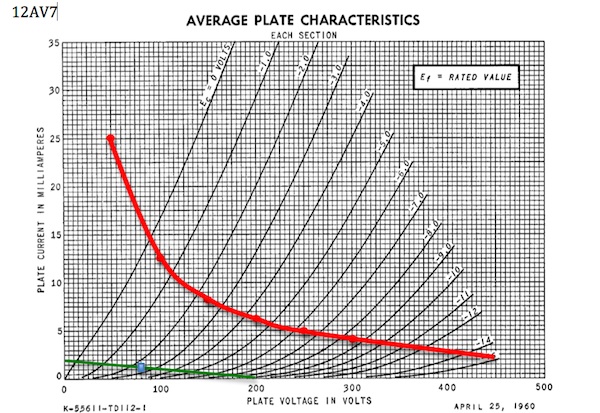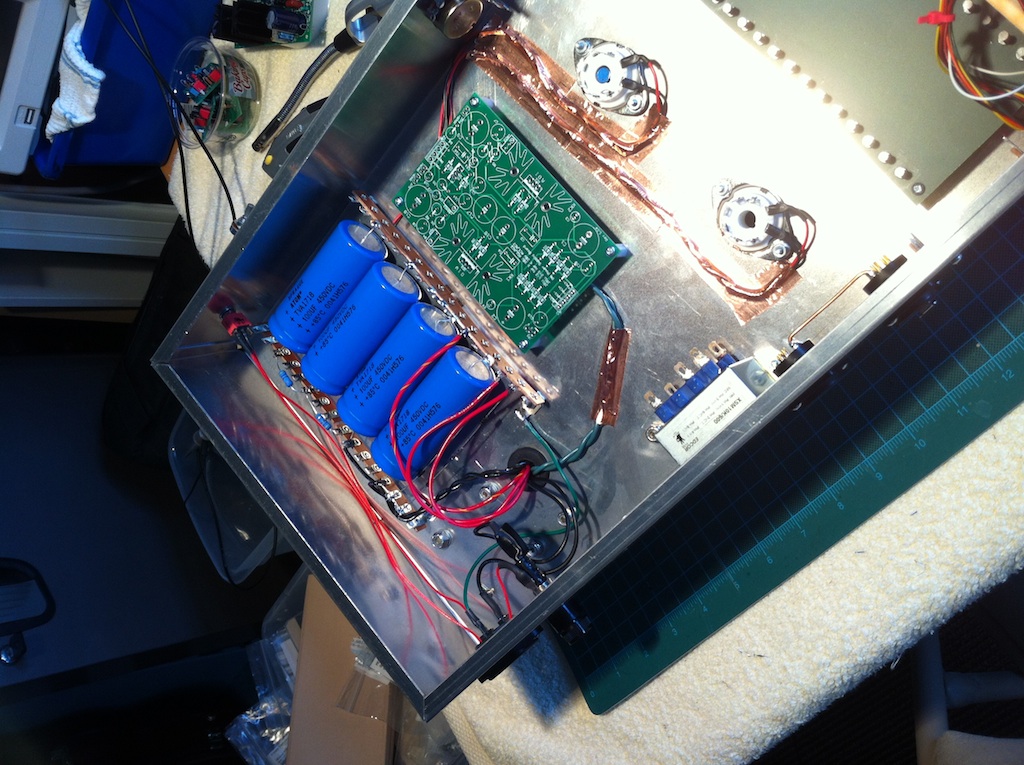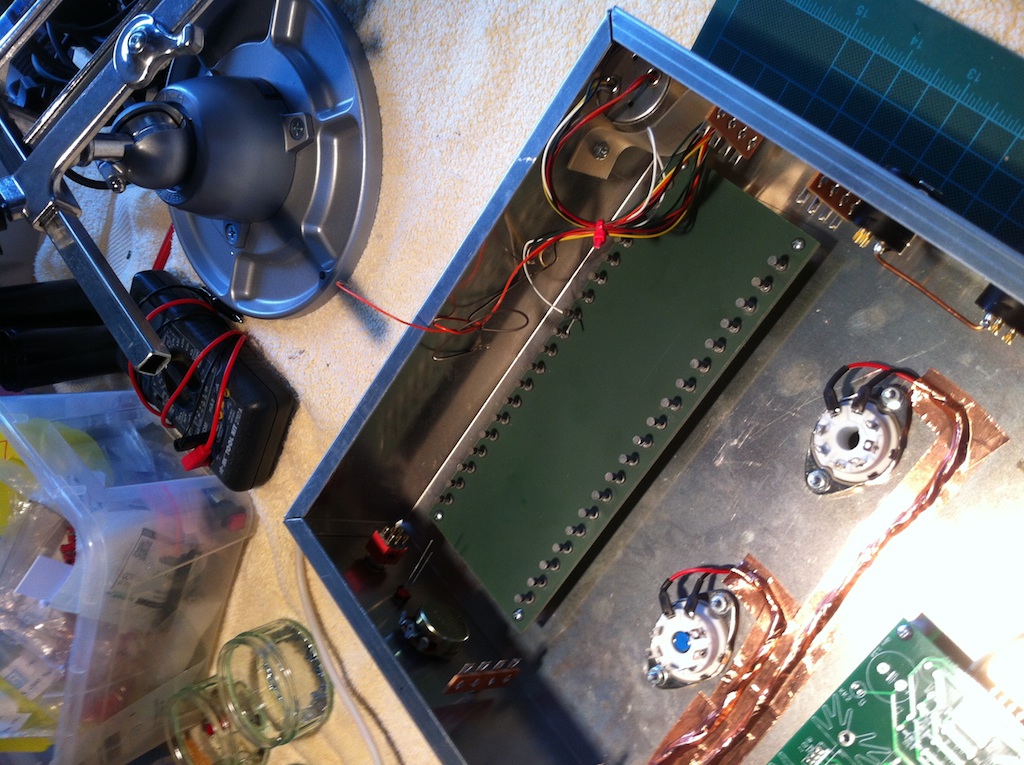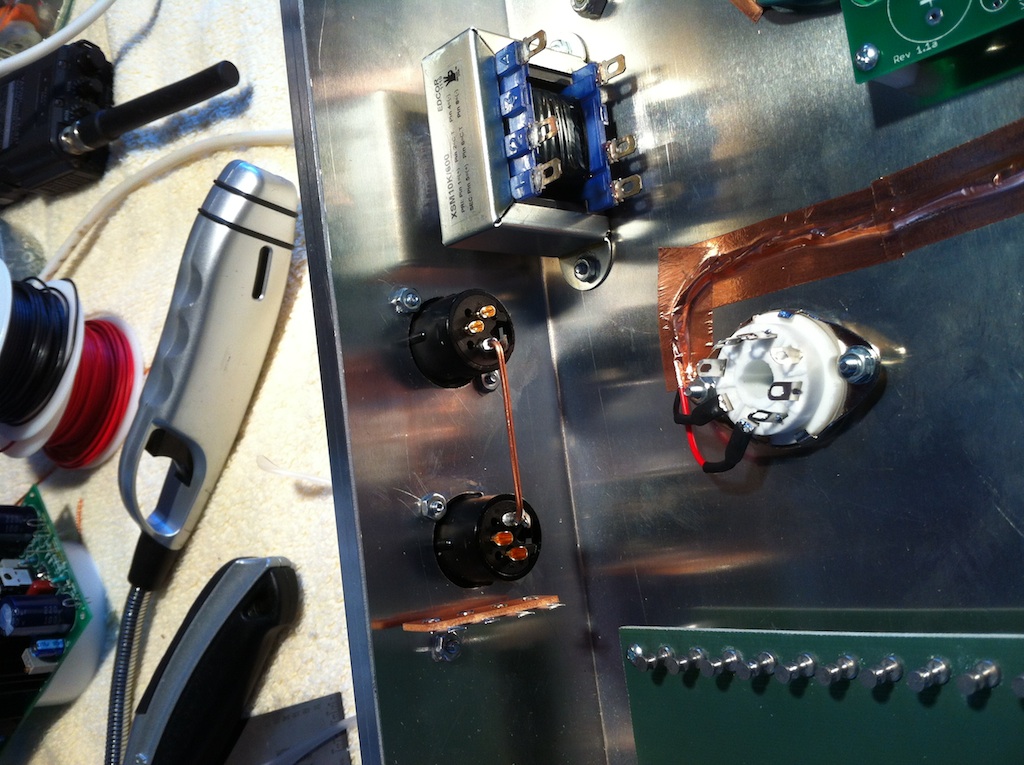Matador
Well-known member
I was looking over the schematic of the MILA preamp by NYD: built with two 12AV7 tubes, with two cascaded voltage gain sections followed by a parallel-tube transformer driver, with adjustable feedback.
I was thinking this topology might be interesting to covert to a 6SN7, but I have run into a few issues so far.
Starting with the first two stages: the first is a standard bypassed common-cathode gain stage with a 100K plate resistor, 200V plate voltage, and a 2.2K cathode resistor. Standard calcs show this arrangement (assume a mu of 37 and plate resistance of about 6k) gives 31db of gain, an output impedance of about 5.5K, has an input P-P voltage swing of 4V and an output swing of about 140V peak-to-peak.
Here's the load line:

First thing, is that this seems like a very 'cold' bias point, down near the bottom of the curves. Any particular reason this point might have been chosen? Is this a pseudo plate-starved mode of operation? I would have raised the plate voltage up to 300V or so and DC biased the tube around 3-5mA (perhaps a 50K ish plate resistor). This seems to be in a more linear region of the tube well away from the max plate dissipation levels (drawn in red).
The second stage is the same, with a 220K plate resistor, a 250V plate voltage, and a 2.2K plate resistor. Gain is about 31db again, output impedance is still about 5.5K, and input peak-to-peak level is even less at about 3.4V P-P.
This is an even colder bias point than the first tube (about 750uA). Assuming the gain pot is up at max, we drive the grid positive at about 2V input signal, so the previous stages max input level is about 100mV P-P before the second stage clips (this would be the DI input, and not even accounting for the voltage gain of the input transformer).
Again, I wonder why such a cold bias point was chosen. Operated at 350V and 3-5mA quiescent current, the stage could have accepted a much larger P-P swing before clipping (perhaps 12V P-P) which would have opened up the headroom...or perhaps I'm missing something else? Maybe operating at low quiescent currents help make the PSU easier to design? Perhaps the non-linearity 'sounds good'?
Lastly, since the plate resistance of the 6SN7 is about 7K, if I design for a single output tube, and then parallel it, I think I need to halve the plate and cathode resistors to keep the same bias point (since current doubles with two parallel tubes). However does the output impedance also drop by half?
I was thinking this topology might be interesting to covert to a 6SN7, but I have run into a few issues so far.
Starting with the first two stages: the first is a standard bypassed common-cathode gain stage with a 100K plate resistor, 200V plate voltage, and a 2.2K cathode resistor. Standard calcs show this arrangement (assume a mu of 37 and plate resistance of about 6k) gives 31db of gain, an output impedance of about 5.5K, has an input P-P voltage swing of 4V and an output swing of about 140V peak-to-peak.
Here's the load line:

First thing, is that this seems like a very 'cold' bias point, down near the bottom of the curves. Any particular reason this point might have been chosen? Is this a pseudo plate-starved mode of operation? I would have raised the plate voltage up to 300V or so and DC biased the tube around 3-5mA (perhaps a 50K ish plate resistor). This seems to be in a more linear region of the tube well away from the max plate dissipation levels (drawn in red).
The second stage is the same, with a 220K plate resistor, a 250V plate voltage, and a 2.2K plate resistor. Gain is about 31db again, output impedance is still about 5.5K, and input peak-to-peak level is even less at about 3.4V P-P.
This is an even colder bias point than the first tube (about 750uA). Assuming the gain pot is up at max, we drive the grid positive at about 2V input signal, so the previous stages max input level is about 100mV P-P before the second stage clips (this would be the DI input, and not even accounting for the voltage gain of the input transformer).
Again, I wonder why such a cold bias point was chosen. Operated at 350V and 3-5mA quiescent current, the stage could have accepted a much larger P-P swing before clipping (perhaps 12V P-P) which would have opened up the headroom...or perhaps I'm missing something else? Maybe operating at low quiescent currents help make the PSU easier to design? Perhaps the non-linearity 'sounds good'?
Lastly, since the plate resistance of the 6SN7 is about 7K, if I design for a single output tube, and then parallel it, I think I need to halve the plate and cathode resistors to keep the same bias point (since current doubles with two parallel tubes). However does the output impedance also drop by half?





